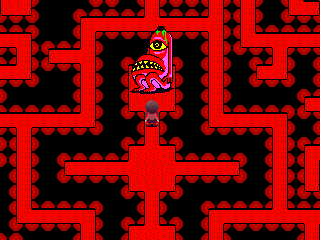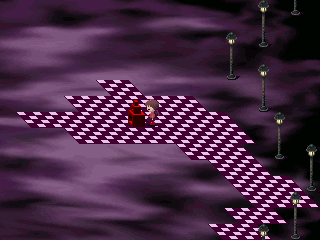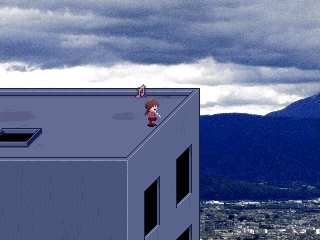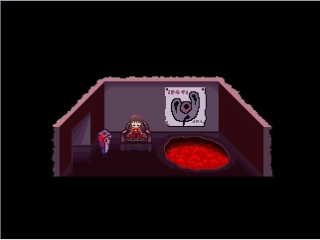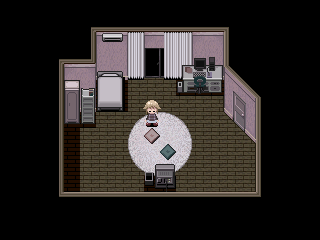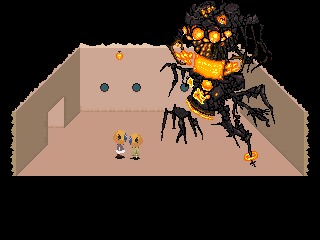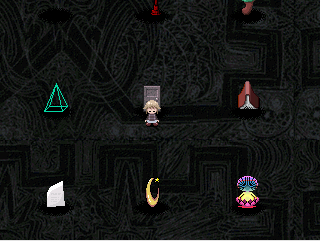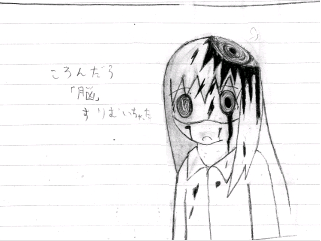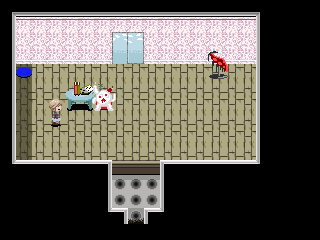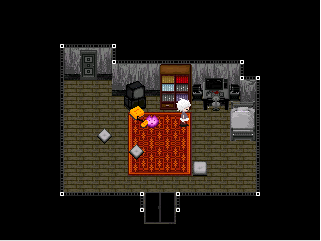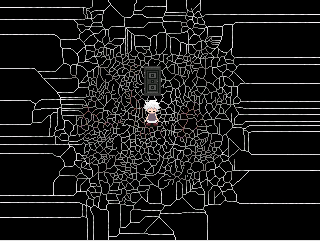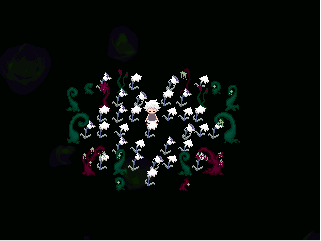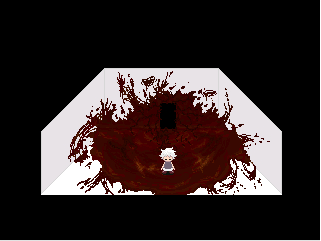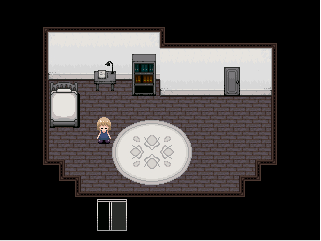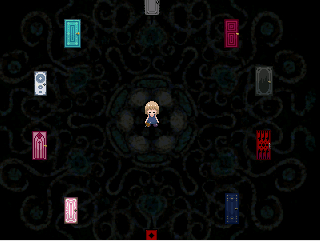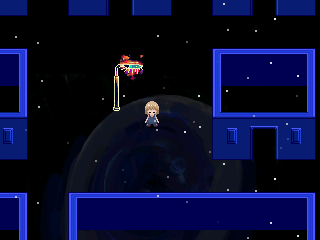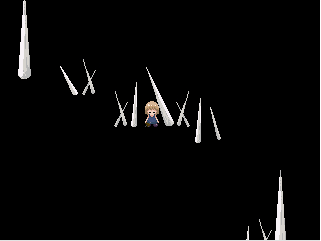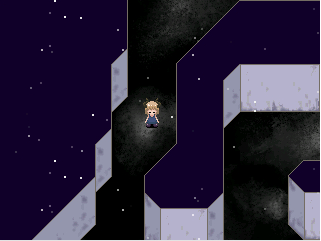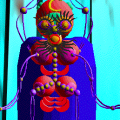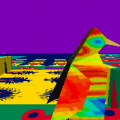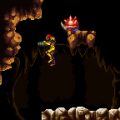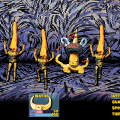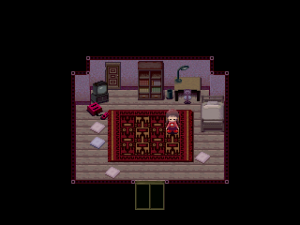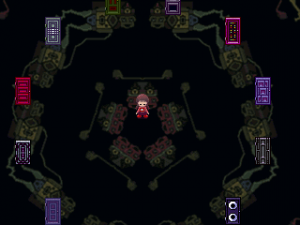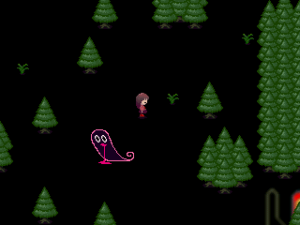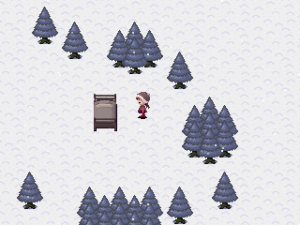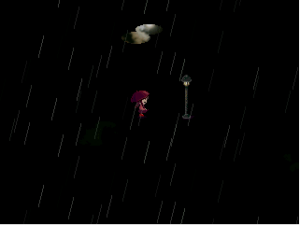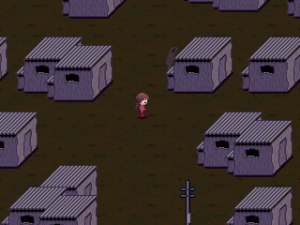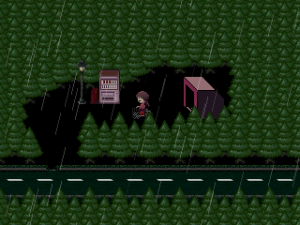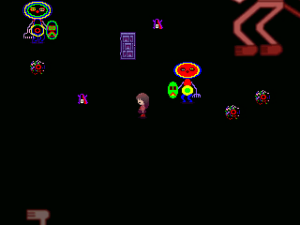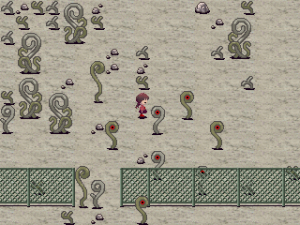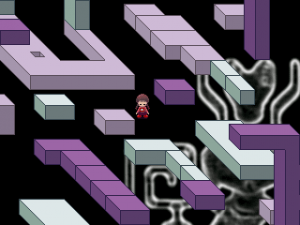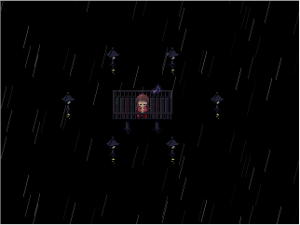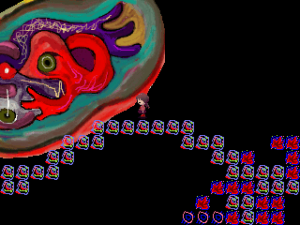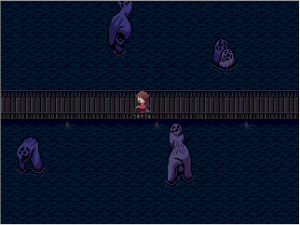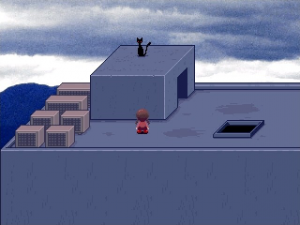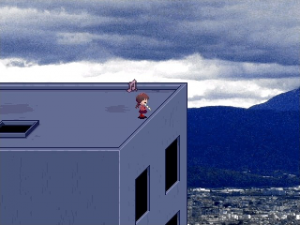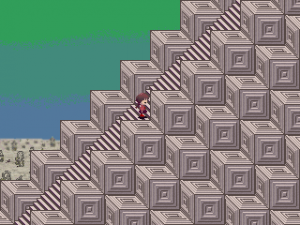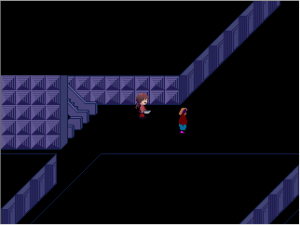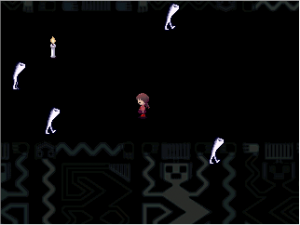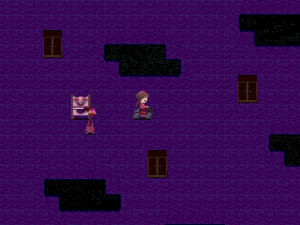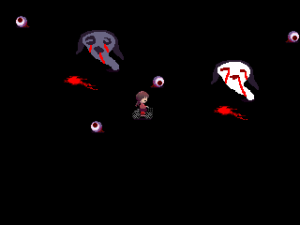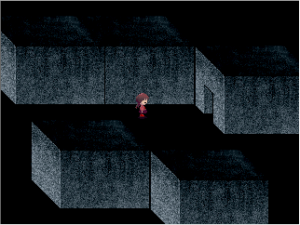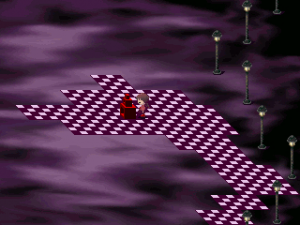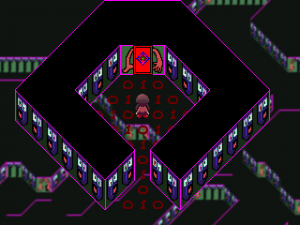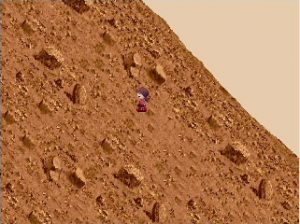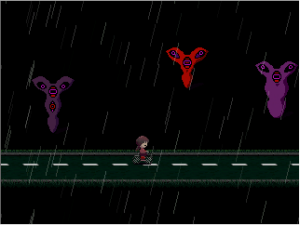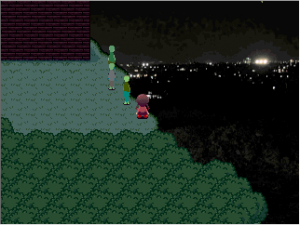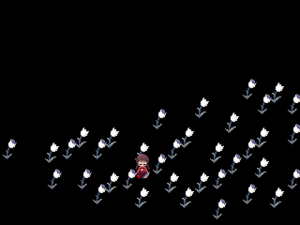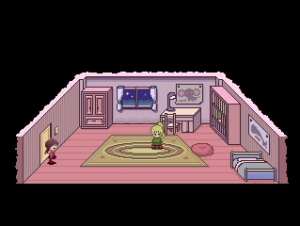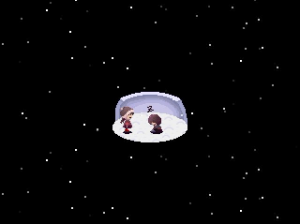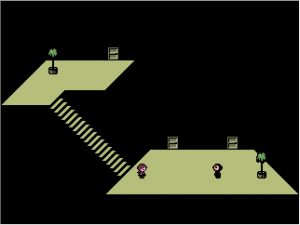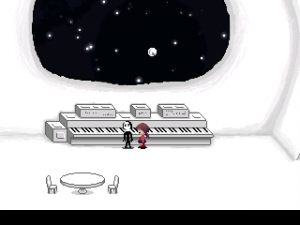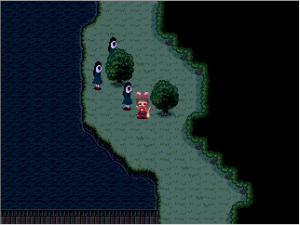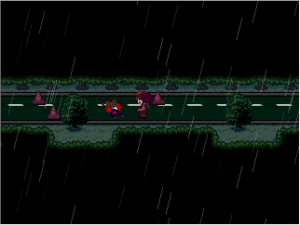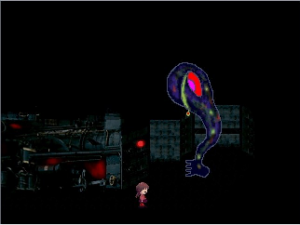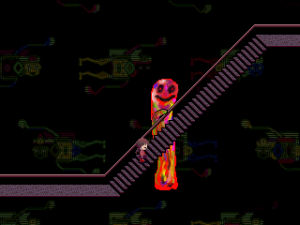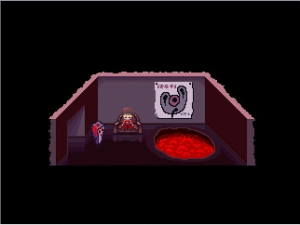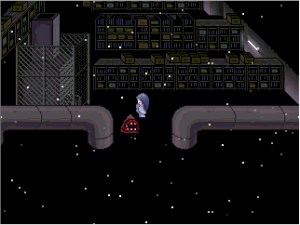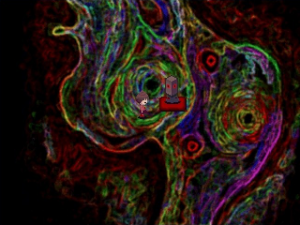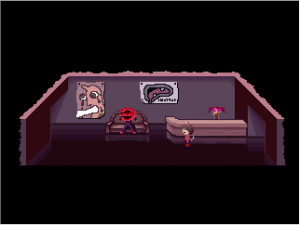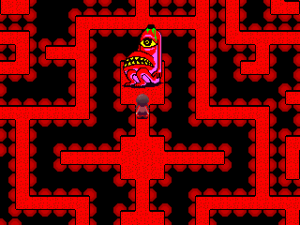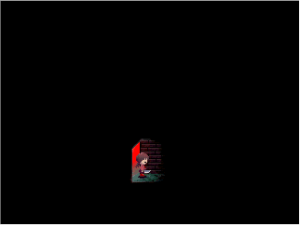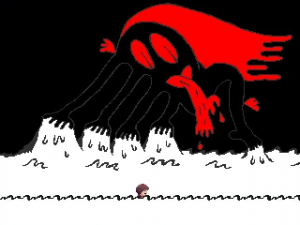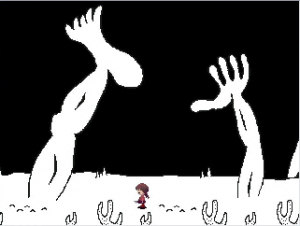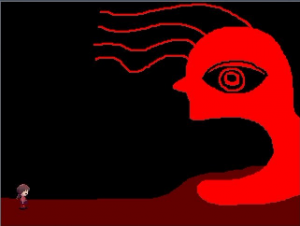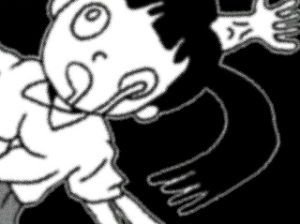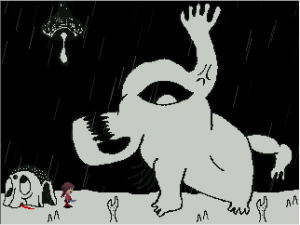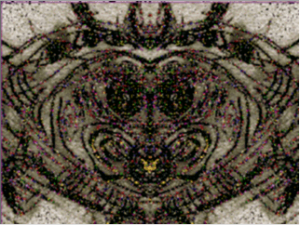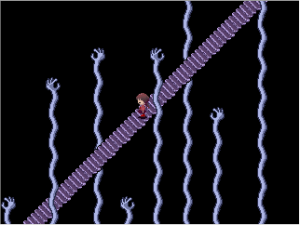Yume Nikki (“Dream Diary”) was created entirely by the somewhat anonymous Japanese developer Kikiyama with RPG Maker. While this software is typically used to design homebrew RPGs, Kikiyama instead utilized it to create an exploration-driven adventure game which he released as freeware. The game first found popularity on a Japanese imageboard and then spread to the four corners of the earth. While the game was simple enough to play using trial and error, the distribution of an English translation has helped it to find an even larger audience.
The game begins in a one-room apartment. The main character, Madotsuki, is a young woman living on her own. She refuses to leave her apartment and is, by all appearances, a shut-in. She lives her life through her dreams, which begin when she crawls into bed. Every dream begins with Madotsuki appearing on her balcony. The apartment looks nearly the same, but you are now able to leave by the front door. It leads to a large, surreal room full of doors–generally called the Nexus. From this central hub, begin to explore the numerous areas in the game.
The opening instructions (viewable in-game from the menu) provide the simple goal inside Madotsuki’s dreamscape: interact with the dream world to collect effects. In the language of the game, effects are various abilities, objects, and appearances that you gain as you explore. If you interact with the correct object or character, you are alerted that you have gotten one of the effects. Some are useful or even essential as you travel, while others exist only to add atmosphere. Effects are easy to miss, and it pays off to interact with anything that seems evens slightly interesting.
Exploring the world of Yume Nikki is challenging to say the least. Like in LSD: Dream Emulator, the dream world is mainly static but still confusing to navigate. For instance, the doors in the Nexus will always lead to the same locations, but most paths are difficult to remember or are only available by random chance. Some are unmarked or require a specific set of actions to enter, and occasionally interacting with an object will transport you to a new location.
Most areas have a distinct personality and design scheme. One is lit up like a neon sign, while another has scattered puddles and lamp posts. The farther and deeper you travel into the dream world, the more unsettling and dangerous the environment becomes. Among the most satisfying accomplishments in the game is to stumble upon an area one has never seen before. Some of the most unusual areas of the game are almost impossible to find and don’t even contain a single effect–they exist only to be found and enjoyed.
While most characters in the game are ominous but pose no real threat, some areas do contain actual enemies. Like in a more traditional survival horror game, the dangerous monsters are difficult to defend against or escape from, and avoidance is generally the best option. There are special events to be uncovered throughout the game. Some could be considered cutscenes, while others are short, playable scenarios. A few are simply a bizarre sight to see. Events are some of the most elusive elements of the game, most appearing only by chance.
The game is such a unique experience that I’d hate to spoil the final goal and ending of the game, so I’ll only comment that the game does indeed have a point. It may be surprising, but all of the information you need in order to finish the game is in front of you. The game is very much an Easter egg hunt.
Yume Nikki is not without its faults. One could try to cop out by saying that its these problems are what make the game so esoteric and intriguing, but that is no excuse. An in-game method to help navigate, such as an auto-map or even just an effect that allowed you to mark doors you had already been though or create a teleportation point that could be returned to without a half-hour trek – these would have been very welcome. The game is hard enough to explore with a walkthrough in front of you. A checklist of events completed would be nice as well, but something that could increase my odds of activating an event beyond a 1/3600 chance would’ve been nice too. If future updates of the game are released, it will be interesting to see how the game’s issue are handled, hopefully without hurting the unique character of the game.
A typical extension of the player experience is seeking out answers online – it’s practically Yume Nikki‘s metagame. Players have discovered and shared many of the game’s secrets. Devotees have created fan art for even the most minor characters, handmade dolls are sold online, and remixed soundtracks abound. The storyline itself is a major source of online discussion; the game’s refusal to explain itself has led to wild speculation about Madotsuki’s background and the meaning of the game’s extensive themes and imagery. From the identity of a corpse to the idea that Madotsuki is actually transgendered, it has all been been debated at length.
The controls are uncomplicated – it could be played on an SNES controller with buttons to spare. What little you need to know to play the game is explained in a short introduction. The graphics are deceptively simple as well. The primary graphics are finely crafted two-dimensional pixel art in the style of the 16-bit era, and is often compared to Earthbound. There is a wide variety of art styles in the game, however, and it’s surprising by what was accomplished visually in the game using interesting images, creative layering effects and eye-catching animation.The game’s soundtrack is well produced, and adds to the experience every step of the way. Most of the music consists of haunting loops. The music is fairly ambient, so most players will not find stand-out tunes. There is also an excellent selection of other sounds used to great effect, such as white noise or feedback.
Yume Nikki‘s cult following demonstrates the impact it is having, and its influence will be inevitably be seen in the future of video games. Like the writing of H.P. Lovecraft, the game may not end up well known, but it will undoubtedly inspire many a creator. As a matter of fact, it is already affecting a crop of game designers.
Fan Games
A surprising number of fan games are at varying stages of development. Close to two dozen games are playable, and many of those are comparable to the original in quality. Most of them are in Japanese, with a few are already translated into English, while several were developed by English speakers. Even without a translation, most can be played using context clues as your guide. Some of the stand outs include .flow, Yume Nisshi, and Yume 2kki.
These games generally follow a formula similar to the original. Characters start off in the waking world and then explore a large dream world in search of effects. The art, music and controls are also very similar. The differences are what really stand out: the main characters and effects provide the most obvious differences. The emerging genre’s use of extremely personal metaphors and themes helps each game have an original style and feel.
It says something for Yume Nikki that it has garnered so many homages. The game’s surface simplicity and its origins as an RPG Maker production make it a prime candidate for imitation. One can imagine the thought process as someone plays the original game: “This is incredible!” followed shortly by “Wait a minute! I could do this!”
Final Thoughts
Here’s a game that was unashamedly ambiguous, making no real attempt to explain itself yet begging to be explored. It was a bottomless rabbit hole disguised as the simplest of adventure games, and its depths were full of pale creatures with rows of jagged teeth. If you are a gamer seeking something truly bizarre, experiential and full of psychological horror, Yume Nikki is the game for you.
True psychological horror is a difficult thing to pull off in any media. For every film like Jacob’s Ladder, there are a dozen like Urban Legend: Bloody Mary. And for every game like Silent Hill, there are a dozen like Escape from Bug Island. Yume Nikki manages to truly get under your skin and stay there. In an environment where independent games are becoming more common and easy to obtain, it’s always encouraging to find a game that is able to accomplish so much and with such a fresh take on the medium. When such a work is then released freely for all to enjoy, it will surely find its audience.
According to online gossip at the game’s wikia, Kikiyama isn’t finished with Yume Nikki, although future progress will be slow. In the meantime, the many games it has inspired are in rapid development, so those wanting to enjoy this twisted type of game will be satisfied for some time.
Links:
Yume Nikki wikia download links for the original game and some fan games.
Nicovideo Extensive list of fan games, in Japanese.
Fan Game Screens
